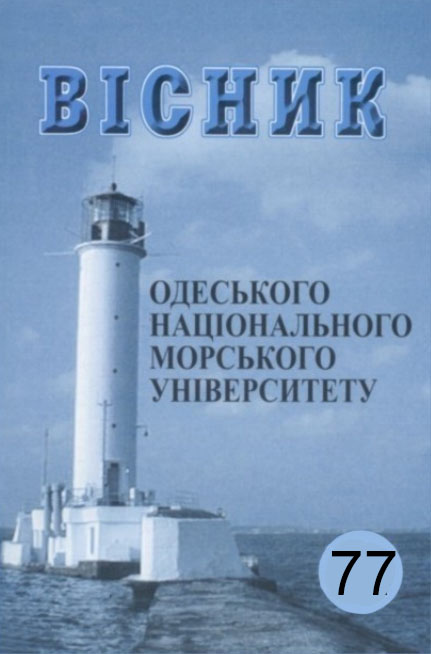Main ecological problems in sea transport. General characterization of environmental problems
Main Article Content
Abstract
The maritime shipping industry, as a crucial component of the global economic system, is actively involved in solving the major global problems of our time, as more than 80 % of international trade is carried out by sea. Growth in the number of ships requires enhanced measures to improve environmental performance and safety of navigation Throughout the history of navigation, ships have been discharging everything that was considered unnecessary into the ocean: food waste, cargo residues, garbage, polluted water, etc. It was believed that the endless and deep sea would not be harmed by this. However, the possibilities of ocean self-cleaning are not unlimited, while the scale of marine activities is constantly growing. In this article, the authors review and systematize the analytical assessments of domestic and international experts on the problem of pollution and climate change, which requires immediate measures to reduce the negative impact of maritime transport on the environment. The purpose of the article is to outline the issues of main environmental problems in maritime transport and to summarize the results of published scientific research. We emphasize that environmental safety issues include the systematization of the constituent factors of marine pollution by oil, chemicals and other toxic substances, greenhouse gas emissions, loss of fuel tanks during accidents, etc. In our opinion, the identification and classification of the main causes of the impact of negative factors of maritime transport operation on the ecology and the state of the environment with a view to further reducing or eliminating this impact is an important topical problem of our time. To achieve the purpose of the study, theoretical methods of systematization, formalization, statistical processing and generalization of environmental monitoring data of domestic and world scientists were used. It is noted that scientific research in this area is considered to be the most promising.
Article Details
References
2. Borschevska O., Dobrov O. (2017). Pravove zabezpechennya ekolohichnoi bezpeki pid chas zdiysnennya morskih perevezen. Pidpriemnitstvo, hospo- darstvo i pravo. № 6. P. 91-95.
3. Varlamov G.B., Lyubchik G.M., Malyarenko V.A. (2003). Teploenerhetichni ustanovki ta ekolohichni aspekti virobnitstva enerhiyi: Pidruchnik. К.: 232 p.
4. Hurenko A.V., Shchenykova E.V., Yevsik M.S. (2017). Doslidzhennia suchasnoho potentsialu morehospodarskoho kompleksu Ukrainy. Visnyk Pryazovskoho tekhnichnoho universytetu [Bulletin of Priazovsky Technical University], Issue 33. P. 218-224.
5. Efremov V.S., Efremov N.V. (1996). Mizhnarodne morske pravo pro zahist ta zberezhennya morskoho seredovischa. V kn.: Mizhnarodno-pravovyi rezhim vikoristannya naukovo-doslidnih suden. К.: 383 p.
6. Leonov V.E., Solyakov O.V., Himich P.G., V.F. Zabezpechennya ekolohich- noyi bezpeki sudnoplavstva (2014): monohrafiya / Hodakivskyi. Herson: HDMA. 188 p.
7. Zahist morskoho seredovischa vid zabrudnennya sudami: «vikliki ta tehno- lohichni rishennya». (2016). Mizhnarodna asotsiatsiya klasifikatsiynih tova- ristv (IACS). https://iacs.org.uk/publications/environmental-considerations/.
8. Kosharska L., Brednyova V., Nikiforov Yu. (2022). Development of green energy at the present stage as a policy of global energy redistribution. Herald of the Odesa National Maritime University. № 1 (67). P. 168-188.
9. Kosharska L., Brednyova V., Nikiforov Yu. (2022). Research of the Regula- rities of «Green» Energy and the World Trends of its Development. Scien- tific journal Transport Development. Odesa National Maritime University. № 4 (45). P. 7-14.
10. Koval V., Kaminskyi O., Brednyova V., Kosharska L. (2022). Digital Ecosystem Model of Labour Resources Management in Economic Militarism Revista Gestion De Las Personas Y Technologia. № 4 (45). P.123-143.
11. Korotkyi T.R. (2010). Istoriko-pravovyi analiz implementatsii mizhnarodno-pravovoi zaboroni zabrudnennya morskoho seredovischa v kriminalne zakonodavstvo Ukraini. Zb. nauk. prats Aktualni probltmi derzhavi i prava: № 55. P. 659-668.
12. Latkina S.A., Ell M.P. (2016). Problemy optymizatsii orhanizatsiinykh protsesiv portovoi diialnosti v Ukraini. Ekonomichnyi visnyk Zaporizkoi derzhavnoi inzhenernoi akademii. 3(03). P. 92-95.
13. Lisenko N.S. (2012). Kompleksna otsinka tehnohennoyi ta ekolohichnoyi bezpeki robotu morskih pidpriemstv v lokalnih rendzhah // Vісник ОНУ ім. І. І. Мечникова. T.17. 1 (6). P. 73-81.
14. Madzhd S.M., Kulinich Ya.I. ( 2017). Naukova metodolohiya otsinuvannya ekolohonebezpechnih risikiv funktsionuvannya tehnohenno-zminenih vodnih ekosistem. Visnik KrNU imeni Mihayila Ostrohradskoho. 4. P. 88-95.
15. Mizhnarodni standarti ta pravila dlya ekolohichnoi bezpeki v morskomu transporti (2010). International Chamber of Shipping (ICS). https://www.ics-shipping.org/shipping-facts/environmental-performance/.
16. Suchasni pidhodi do visokoefektivnoho vikoristannya zasobiv transportu. (2020). Monohrafiya/za redaktsieyu V.Chimshir. Izmail: DI NU «OMA». K.: 472 p.
17. Udod V.M., Madzhd S.M., Kulinich Ya.I. (2017). Rehionalni osoblivosti strukturno-funktsionalnoi orhanizatsiyi rozvitku tehnohenno zminenih vodnih sistem. Visnik KrNU imeni Mihaiyla Ostrohradskoho. 3. P. 93-99.
18. Urum N.S., Trofimenko I.V., Ryaschenko O.I., Ivanenko V.V. Klasifikatsiya osnovnih prichin nehativnoho vplivu vodnoho transportu na ekolohiyu i stan navkolishnyoho seredovischa. (2021). Vcheni zapiski TNU imeni V.I. Ver- nadskoho. Seriyaя: Tehnichni nauki. T.32 (71). № 6. P. 257-261.
19. Chimshir V.I., Danilenko O.B., Shulha Yu.M. (2023). Bezpeka sudno- plavstva na morskomu ta vnutrishnyomu vodnomu transporti yak ob’ekt naukovih doslidzhen. Vodnyi transport. Zb.nauk.prats Derzhavnoho universitetu infrastrukturi ta tehnolohyi. K.: DUIT. № 2 (38). P. 231-241.
20. Sheluhin O.M. Normativne zabezpechennya bezpeki sudnoplavstva pid chas zdiysnennya perevezen morskim transportom (2021). Yuridichnyi naukovyi elektronnyi zhurnal. № 4. P. 664-665.
21. Illiyas F., Mohan K. Onshore preparedness for hazardous chemical marine vessels accidents: A case study. (2016). Journal of Disaster Risk Studies. № 8 (1). P. 1-7.
22. United Nations Economic Commission for Europe – UNECE. (2009). Recommendation on the transport of dangerous goods, model regulations. New York and Geneva. № 8. P. 1230-1242.
23. IMO. In: Guidelines for the reduction of underwater noise from commercial shipping to address adverse impacts on marine life. (2014). 21st ASCOBANS Advisory Meeting, MEPC.1. Circ. 833. http://www.ascobans.org/sites/default/files/document/AC21_Inf_3.2.1_IMO_NoiseGuidelines.pdf.
